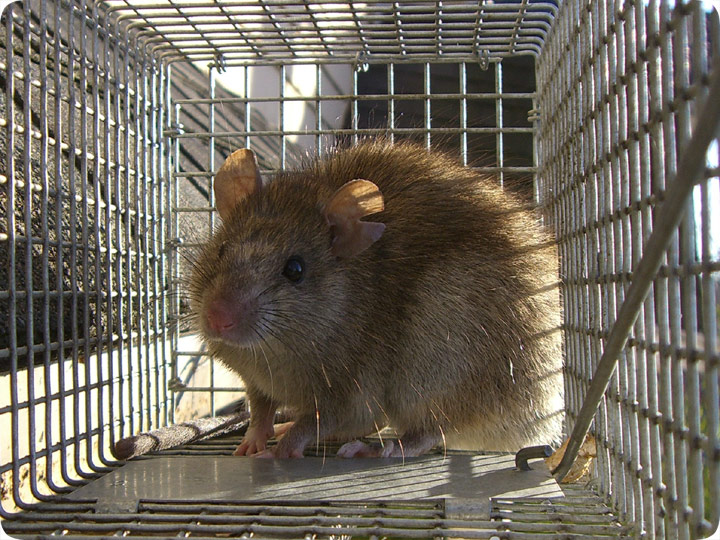-
info@aaanimalcontrol.com
Call us for help in your town
Humane Wildlife Education
Norway Rat Control & Trapping

01.05.2008 - Here is a photo of a Norway Rat (rattus norvegicus) trapped in a cage trap. I usually deal with Roof Rats in Florida. This photo was sent to me by my brother-in-law Sean, who operates his own wildlife removal business in Seattle, WA. He deals with more with
Norway Rats up there. Thought I trained him on Roof Rats down here in Orlando, most of the same principles and techniques apply to both rat species. These rats are by far the dominant rat species in the world, and both occupy a certain ecological niche and thrive as nuisance rodent
species worldwide. I will now examine the differences between these two types of rats:
The Roof Rat tends to live in warmer climates, including tropical climates. It is more grey in color, and it's smaller and sleeker. Adults average a 7-inch body and 8-inch tail, and weigh 12 ounces. These rats prefer to live in high areas, off the ground, such as in treetops,
and they mostly travel off the ground. They will eat a varied diet and seem to prefer to eat fruits or grains.
The Norway Rat lives in more northern areas. They are more brown in color, and stockier in build. Adults average an 8-inch body and 6-inch tail and weigh 16 ounces. These rats prefer to live on the ground and underground. These are the large types of rats found in the city
sewers. They will eat most anything, and seem to prefer meats.
These rats do co-exist, with the Roof Rats living high and the Norway Rats living low. The larger Norway Rats tend to kick out the smaller roof rats when there's competition for the same space. However, I've never observed any of this behavior personally, since I've dealt exclusively with
the Roof Rats in Florida.
Sean says that Norway Rats are similar in terms of control and trapping techniques. The key is still to find and seal shut all the entry points into the building. Like me, Sean mostly uses snap traps. However, in this case, he set a cage trap along the gutter at the roofline of the house, and
caught this fine specimen. I like the little tear in its ear, and think it's a handsome fellow.
Do it yourself: Visit my How To Get Rid of Rats page for tips and advice.
Get professional help: Visit my Nationwide Pro Directory of wildlife removal experts.
For more wildlife stories, click my Wildlife Blog
or click my below banner to hire a local trapper.
The Norway rat (Rattus norvegicus) is a misnomer and the Norway rat is actually a native to northern China. International trade in the 18th century brought these rats all over the world and they can now be found on every continent except Antarctica. Norway rats are also widely known as brown rats throughout the United States, which seems to be a more appropriate name.
Are Norway Rats Dangerous? Why Are They Larger in Urban Areas?
Norway rats are rather dangerous for a variety of reasons. These rats can carry various diseases like plague, jaundice, rat-bite fever, and many others that are spread through their feces, urine, or by getting bitten. Additionally, sometimes Norway rats carry fleas or ticks which can quickly become quite an issue. Your house can also get severely damaged overtime by rats gnawing on its wiring and foundations. If they get the chance, rats will also go into your pantry and eat some food-- which makes it possible for you to get a disease if you eat the food later.
Norway rats are larger in urban areas because they've adapted to urban areas and the dangers within them. Norway rats must be large to displace other rodent species who try to steal their food or shelter. Additionally, their size helps them keep warm in the winter months. Between being on the top of the rat food chain and surplus food (trash), Norway rats have reproduced and evolved at an unprecedented rate throughout the world but especially in the United States.
Signs of Infestation
Droppings are the first thing you should be looking for if you believe Norway rats have infested your house. Norway rats have capsule-shaped excrement that ranges between 1.8-2 cm long. Usually, you'll find areas where these droppings are more frequent: this is an area that rats regularly traverse through. You should also watch out for gnawing marks on furniture and grease stains as these will seem to signify a rat living in your house.
How Do I Get Rid of Norway Rats?
There are a few good ways that you can get rid of Norway rats. Generally, when trying to get rid of an animal, you'll want to start with the most humane method and work your way down the list, only killing the animal or hiring an exterminator as a last resort. Additionally, when you're trying to get rid of the rats, try to find out the root of the issue: why did they come in? How did they get in? Finding answers to questions like these will keep future infestations at bay.
The first thing to do for a Norway rat infestation is to make your property unattractive to them. Try sealing garbage cans, sealing any entrances, clean your house, and reduce water sources by fixing your plumbing or any leaks. If the rats do not get discouraged enough to leave your house, then your best option is to simply hire an exterminator to get rid of them. Just make sure that you find where and why they came in and have rectified the situation, otherwise, another infestation will take place in your house.




















